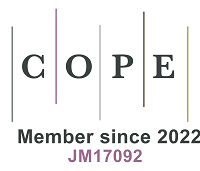REFERENCES
1. GBD 2021 Risk Factors Collaborators. Global burden and strength of evidence for 88 risk factors in 204 countries and 811 subnational locations, 1990-2021: a systematic analysis for the Global Burden of Disease Study 2021. Lancet 2024, 403, 2162-203.
2. Garcia, A.; Santa-Helena, E.; De Falco, A.; de Paula Ribeiro, J.; Gioda, A.; Gioda, C. R. Toxicological effects of fine particulate matter (PM2.5): health risks and associated systemic injuries-systematic review. Water. Air. Soil. Pollut. 2023, 234, 346.
3. Zhai, X.; Wang, J.; Sun, J.; Xin, L. PM2.5 induces inflammatory responses via oxidative stress-mediated mitophagy in human bronchial epithelial cells. Toxicol. Res. 2022, 11, 195-205.
4. Li, H.; Zhao, Z.; Luo, X. S.; et al. Insight into urban PM2.5 chemical composition and environmentally persistent free radicals attributed human lung epithelial cytotoxicity. Ecotoxicol. Environ. Saf. 2022, 234, 113356.
5. Chowdhury, S.; Pozzer, A.; Haines, A.; et al. Global health burden of ambient PM2.5 and the contribution of anthropogenic black carbon and organic aerosols. Environ. Int. 2022, 159, 107020.
6. Alves, C.; Evtyugina, M.; Vicente, E.; et al. PM2.5 chemical composition and health risks by inhalation near a chemical complex. J. Environ. Sci. 2023, 124, 860-74.
7. Qi, Z.; Zhang, Y.; Chen, Z. F.; et al. Chemical identity and cardiovascular toxicity of hydrophobic organic components in PM2.5. Ecotoxicol. Environ. Saf. 2020, 201, 110827.
8. Yan, R. H.; Peng, X.; Lin, W.; et al. Trends and challenges regarding the source-specific health risk of PM2.5-bound metals in a Chinese megacity from 2014 to 2020. Environ. Sci. Technol. 2022, 56, 6996-7005.
9. Johnston, M. V.; Kerecman, D. E. Molecular characterization of atmospheric organic aerosol by mass spectrometry. Annu. Rev. Anal. Chem. 2019, 12, 247-74.
10. Hites, R. A. Mass spectrometric identification of pollutants in the environment: a personal and bibliometric perspective. J. Am. Soc. Mass. Spectrom. 2022, 33, 620-6.
11. Jiang, X.; Xu, F.; Qiu, X.; et al. Hydrophobic organic components of ambient fine particulate matter (PM2.5) associated with inflammatory cellular response. Environ. Sci. Technol. 2019, 53, 10479-86.
12. Yu, L.; Liu, W.; Wang, X.; et al. A review of practical statistical methods used in epidemiological studies to estimate the health effects of multi-pollutant mixture. Environ. Pollut. 2022, 306, 119356.
13. Shi, X.; Qiu, X.; Jiang, X.; Rudich, Y.; Zhu, T. Comprehensive detection of nitrated aromatic compounds in fine particulate matter using gas chromatography and tandem mass spectrometry coupled with an electron capture negative ionization source. J. Hazard. Mater. 2021, 407, 124794.
14. Jia, Y. Y.; Wang, Q.; Liu, T. Toxicity research of PM2.5 compositions in vitro. Int. J. Environ. Res. Public. Health. 2017, 14, 232.
15. Zhang, Y.; Zhang, R.; Ma, Q.; et al. A feature selection and multi-model fusion-based approach of predicting air quality. ISA. Trans. 2020, 100, 210-20.
16. Sheridan, R. P.; Wang, W. M.; Liaw, A.; Ma, J.; Gifford, E. M. Extreme gradient boosting as a method for quantitative structure-activity relationships. J. Chem. Inf. Model. 2016, 56, 2353-60.
17. Låg, M.; Øvrevik, J.; Refsnes, M.; Holme, J. A. Potential role of polycyclic aromatic hydrocarbons in air pollution-induced non-malignant respiratory diseases. Respir. Res. 2020, 21, 299.
18. Øvrevik, J.; Refsnes, M.; Låg, M.; Holme, J. A.; Schwarze, P. E. Activation of proinflammatory responses in cells of the airway mucosa by particulate matter: oxidant- and non-oxidant-mediated triggering mechanisms. Biomolecules 2015, 5, 1399-440.
19. Rojas, G. A.; Saavedra, N.; Saavedra, K.; et al. Polycyclic aromatic hydrocarbons (PAHs) exposure triggers inflammation and endothelial dysfunction in BALB/c mice: a pilot study. Toxics 2022, 10, 497.
20. Niu, X.; Ho, S. S. H.; Ho, K. F.; et al. Atmospheric levels and cytotoxicity of polycyclic aromatic hydrocarbons and oxygenated-PAHs in PM2.5 in the Beijing-Tianjin-Hebei region. Environ. Pollut. 2017, 231, 1075-84.
21. Honda, A.; Inoue, K. I.; Higashihara, M.; Ichinose, T.; Ueda, K.; Takano, H. Differential pattern of cell death and ROS production in human airway epithelial cells exposed to quinones combined with heated-PM2.5 and/or Asian sand dust. Int. J. Mol. Sci. 2023, 24, 10544.
22. Jiang, X.; Han, Y.; Qiu, X.; et al. Personal exposure to electrophilic compounds of fine particulate matter and the inflammatory response: the role of atmospheric transformation. J. Hazard. Mater. 2022, 432, 128559.
23. Gao, R.; Jiang, Z.; Wu, X.; Cai, Z.; Sang, N. Metabolic regulation of tumor cells exposed to different oxygenated polycyclic aromatic hydrocarbons. Sci. Total. Environ. 2024, 907, 167833.
24. Idowu, O.; Semple, K. T.; Ramadass, K.; O’Connor, W.; Hansbro, P.; Thavamani, P. Beyond the obvious: environmental health implications of polar polycyclic aromatic hydrocarbons. Environ. Int. 2019, 123, 543-57.
25. Honda, A.; Inoue, K.; Takai, S.; Kameda, T.; Ueda, K.; Takano, H. Effects of oxidized pyrenes on the biological responses in the human bronchial epithelial cells. Appl. Sci. 2022, 12, 9664.
26. Kameda, T.; Akiyama, A.; Toriba, A.; Tang, N.; Hayakawa, K. Atmospheric formation of hydroxynitropyrenes from a photochemical reaction of particle-associated 1-nitropyrene. Environ. Sci. Technol. 2011, 45, 3325-32.
27. Tuet, W. Y.; Chen, Y.; Fok, S.; et al. Chemical and cellular oxidant production induced by naphthalene secondary organic aerosol (SOA): effect of redox-active metals and photochemical aging. Sci. Rep. 2017, 7, 15157.
28. Yang, B.; Wang, Y.; Fang, C.; Song, E.; Song, Y. Polybrominated diphenyl ether quinone exposure leads to ROS-driven lysosomal damage, mitochondrial dysfunction and NLRP3 inflammasome activation. Environ. Pollut. 2022, 311, 119846.
29. Liu, J.; Fu, M.; Miao, J.; et al. The toxicity of cooking oil fumes on human bronchial epithelial cells through ROS-mediated MAPK, NF-κB signaling pathways and NLRP3 inflammasome. Environ. Toxicol. 2022, 37, 1071-80.
30. Kim, M. J.; Pelloux, V.; Guyot, E.; et al. Inflammatory pathway genes belong to major targets of persistent organic pollutants in adipose cells. Environ. Health. Perspect. 2012, 120, 508-14.
31. Shang, Y.; Zhou, Q.; Wang, T.; et al. Airborne nitro-PAHs induce Nrf2/ARE defense system against oxidative stress and promote inflammatory process by activating PI3K/Akt pathway in A549 cells. Toxicol. In. Vitro. 2017, 44, 66-73.
32. Ichihara, S.; Yamada, Y.; Gonzalez, F. J.; Nakajima, T.; Murohara, T.; Ichihara, G. Inhibition of ischemia-induced angiogenesis by benzo[a]pyrene in a manner dependent on the aryl hydrocarbon receptor. Biochem. Biophys. Res. Commun. 2009, 381, 44-9.
33. Kohno, R.; Nagata, Y.; Ishihara, T.; et al. Benzo[a]pyrene induces NLRP1 expression and promotes prolonged inflammasome signaling. Front. Immunol. 2023, 14, 1154857.
34. Kono, M.; Okuda, T.; Ishihara, N.; et al. Chemokine expression in human 3-dimensional cultured epidermis exposed to PM2.5 collected by cyclonic separation. Toxicol. Res. 2023, 39, 1-13.
35. Lei, Y.; Wang, Z.; Xu, H.; et al. Characteristics and health risks of parent, alkylated, and oxygenated PAHs and their contributions to reactive oxygen species from PM2.5 vehicular emissions in the longest tunnel in downtown Xi’an, China. Environ. Res. 2022, 212, 113357.
36. Liu, B.; Shen, L. J.; Zhao, T. X.; et al. Automobile exhaust-derived PM2.5 induces blood-testis barrier damage through ROS-MAPK-Nrf2 pathway in sertoli cells of rats. Ecotoxicol. Environ. Saf. 2020, 189, 110053.
37. Riaz, H.; Syed, B. M.; Laghari, Z.; Pirzada, S. Analysis of inflammatory markers in apparently healthy automobile vehicle drivers in response to exposure to traffic pollution fumes. Pak. J. Med. Sci. 2020, 36, 657-62.
38. Niu, X.; Yu, J.; Zhang, N.; et al. Human pulmonary cytotoxicity of vehicular derived PM2.5: a study from three characterized tunnels. Atmos. Environ. 2024, 326, 120481.
39. Kc, B.; Mahapatra, P. S.; Henry, A.; et al. Inflammatory effects of short-term exposure to smoke emissions from biomass fuels. In ISES-ISEE 2018 Joint Annual Meeting: Addressing Complex Local and Global Issues in Environmental Exposure and Health, 2018.







